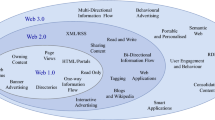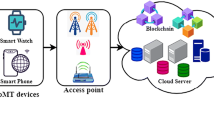Abstract
Smart city architecture development has become a significant research domain. Internet of Things (IoT) has become a principal element in the development of the smart paradigm. However, data security is a primary concern here as a massive amount of data collection is involved. In the field of data security, blockchain is a key technology today. In this paper, we have proposed a blockchain and dew computing-based architecture for a smart city model. The proposed model is a four-tier architecture containing physical nodes, dew, edge, and cloud. We have used the local blockchain application in the dew tier, whereas, in the cloud tier, we have used the global blockchain application. The proposed architecture reduces the latency ~ (25–30)% and power consumption ~ (35–41)% using two different blockchain applications. We have used Amazon Web Services (AWS) in our work while designing the global blockchain application. The CloudWatch monitoring tool has demonstrated the status of the global blockchain database.












Similar content being viewed by others
References
Sarkar S, Misra S (2016) Theoretical modelling of fog computing: a green computing paradigm to support IoT applications. IET Netw 5(2):23–29
Dutta J, Roy S (2017) IoT-fog-cloud based architecture for smart city: prototype of a smart building. In 2017 7th International Conference on Cloud Computing, Data Science & Engineering-Confluence. IEEE, pp 237–242.
Hati S, Dey P, De D (2019) WLAN based energy efficient smart city design. Microsyst Technol 25(5):1599–1612
Markus A, Kertesz A (2020) A survey and taxonomy of simulation environments modelling fog computing. Simul Model Pract Theory 101:102042
Ray PP (2017) An introduction to dew computing: definition, concept and implications. IEEE Access 6:723–737
Wang Y (2016) Definition and categorization of dew computing. Open J Cloud Comput (OJCC) 3(1):1–7
Halpin H, Piekarska M (2017) Introduction to security and privacy on the blockchain. In 2017 IEEE European symposium on security and privacy workshops (EuroS&PW) IEEE, pp 1–3.
Biswas K, Muthukkumarasamy V (2016) Securing smart cities using blockchain technology. In 2016 IEEE 18th international conference on high performance computing and communications; IEEE 14th International Conference on Smart City; IEEE 2nd International Conference on Data Science And Systems IEEE (HPCC/SmartCity/DSS), pp 1392–1393.
Wilczyński A, Kołodziej J (2020) Modelling and simulation of security-aware task scheduling in cloud computing based on Blockchain technology. Simul Model Pract Theory 99:102038
Sharma PK, Kumar N, Park JH (2018) Blockchain-based distributed framework for automotive industry in a smart city. IEEE Trans Ind Inf 15(7):4197–4205
Patel HM, Chaudhari RR, Prajapati KR, Patel AA (2018) The interdependent part of cloud computing: dew computing. Intelligent communication and computational technologies. Springer, Singapore, pp 345–355
Gordienko Y, Stirenko S, Alienin O, Skala K, Sojat Z, Rojbi A, Coto A L (2017) Augmented coaching ecosystem for non-obtrusive adaptive personalized elderly care on the basis of Cloud-Fog-Dew computing paradigm. In 2017 40th International Convention on Information and Communication Technology, Electronics and Microelectronics (MIPRO) IEEE, pp 359–364.
Mukherjee A, Ghosh S, Behere A, Ghosh SK, Buyya R (2020) Internet of health things (IoHT) for personalized health care using integrated edge-fog-cloud network. J Ambient Intell Humaniz Comput 12:1–17
Mukherjee A, Deb P, De D, Buyya R (2019) IoT-F2N: An energy-efficient architectural model for IoT using Femtolet-based fog network. J Supercomput 75(11):7125–7146
Kim NY, Ryu JH, Kwon BW, Pan Y, Park JH (2018) CF-CloudOrch: container fog node-based cloud orchestration for IoT networks. J Supercomput 74(12):7024–7045
Sarkar S, Chatterjee S, Misra S (2015) Assessment of the suitability of fog computing in the context of Internet of Things. IEEE Trans Cloud Comput 6(1):46–59
Zhou J, Leppanen T, Harjula E, Ylianttila M, Ojala T, Yu C, Yang LT (2013) Cloudthings: a common architecture for integrating the Internet Of Things with cloud computing. In Proceedings of the 2013 IEEE 17th International Conference On Computer Supported Cooperative Work In Design (CSCWD) IEEE, pp 651–657.
Varghese B, Buyya R (2018) Next generation cloud computing: new trends and research directions. Futur Gener Comput Syst 79:849–861
Buyya R, Vecchiola C, Selvi ST (2013) Mastering cloud computing: foundations and applications programming. Newnes
Kosba A, Miller A, Shi E, Wen Z, Papamanthou C (2016). Hawk: the blockchain model of cryptography and privacy-preserving smart contracts. In 2016 IEEE Symposium On Security And Privacy (SP), pp 839–858.
Eyal I, Gencer AE, Sirer E G, Van Renesse R (2016) Bitcoin-ng: a scalable blockchain protocol. In 13th {USENIX} Symposium On Networked Systems Design And Implementation ({NSDI} 16), pp 45–59.
Cachin C (2016) Architecture of the hyperledger blockchain fabric. In: Workshop on distributed cryptocurrencies and consensus ledgers, vol 310, no 4, pp 1–4
Wang X, Zha X, Ni W, Liu RP, Guo YJ, Niu X, Zheng K (2019) Survey on blockchain for Internet of Things. Comput Commun 136:10–29
Sharma PK, Park JH (2018) Blockchain based hybrid network architecture for the smart city. Futur Gener Comput Syst 86:650–655
Bibri SE (2018) The IoT for smart sustainable cities of the future: An analytical framework for sensor-based big data applications for environmental sustainability. Sustain Cities Soc 38:230–253
Jegadeesan S, Azees M, Kumar PM, Manogaran G, Chilamkurti N, Varatharajan R, Hsu CH (2019) An efficient anonymous mutual authentication technique for providing secure communication in mobile cloud computing for smart city applications. Sustain Cities Soc 49:101522
Khan Z, Pervez Z, Abbasi AG (2017) Towards a secure service provisioning framework in a smart city environment. Futur Gener Comput Syst 77:112–135
Sanchez L, Muñoz L, Galache JA, Sotres P, Santana JR, Gutierrez V, Pfisterer D (2014) SmartSantander: IoT experimentation over a smart city testbed. Comput Netw 61:217–238
Rasori M, Perazzo P, Dini G (2020) A lightweight and scalable attribute-based encryption system for smart cities. Comput Commun 149:78–89
Author information
Authors and Affiliations
Corresponding author
Additional information
Publisher's Note
Springer Nature remains neutral with regard to jurisdictional claims in published maps and institutional affiliations.
Rights and permissions
About this article
Cite this article
Hati, S., De, D. & Mukherjee, A. DewBCity: blockchain network-based dew-cloud modeling for distributed and decentralized smart cities. J Supercomput 78, 8977–8997 (2022). https://doi.org/10.1007/s11227-021-04203-7
Accepted:
Published:
Issue Date:
DOI: https://doi.org/10.1007/s11227-021-04203-7




